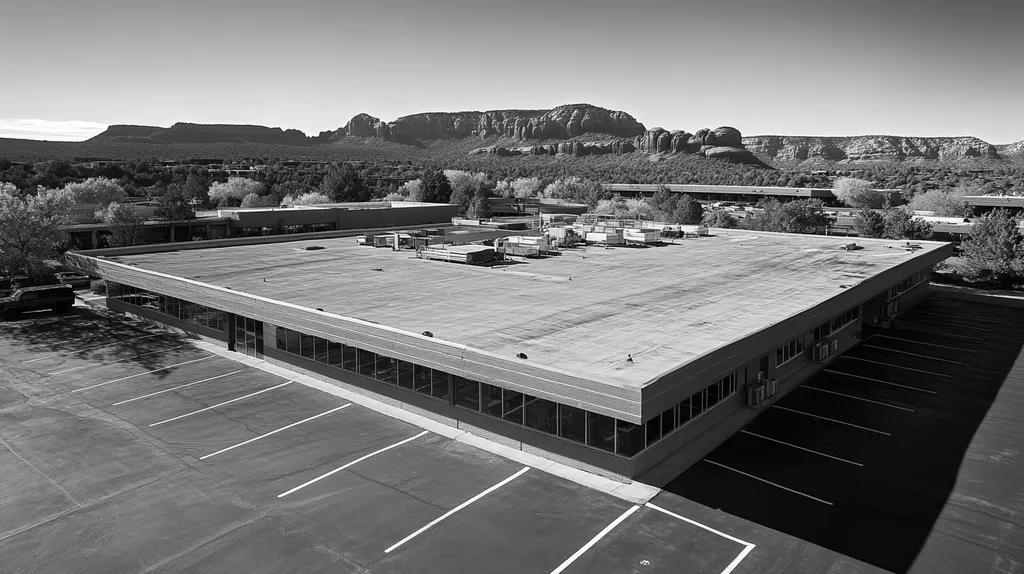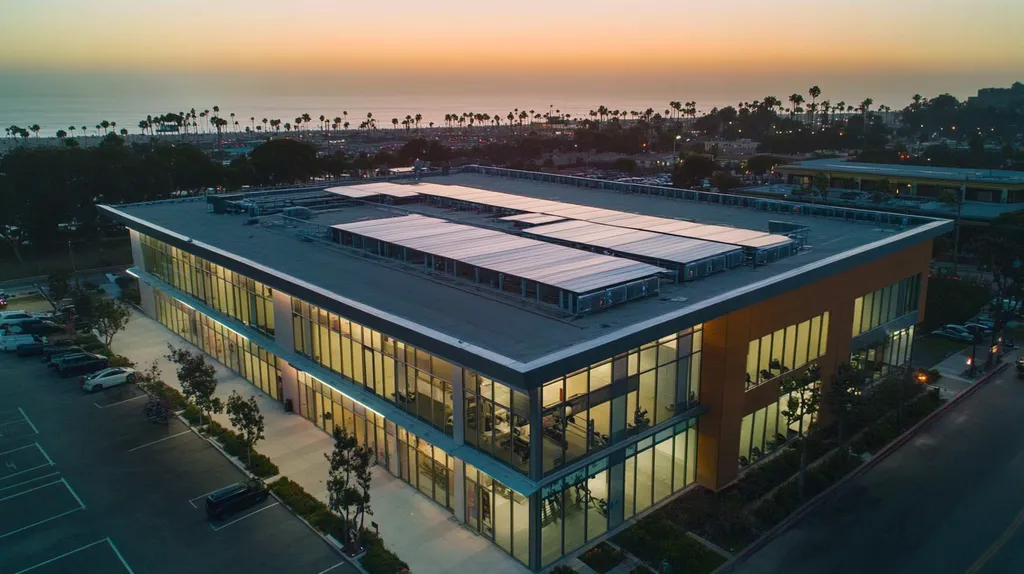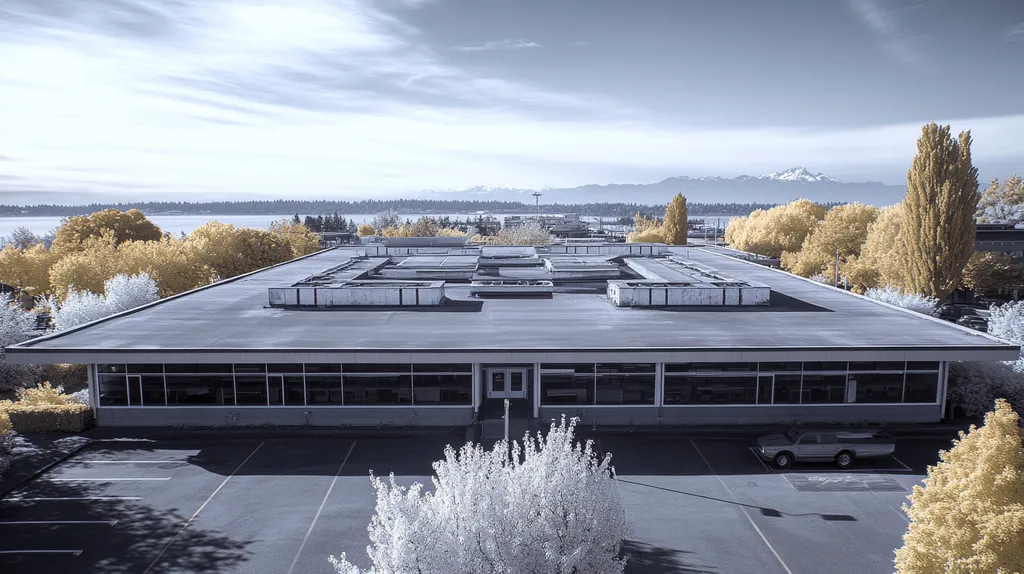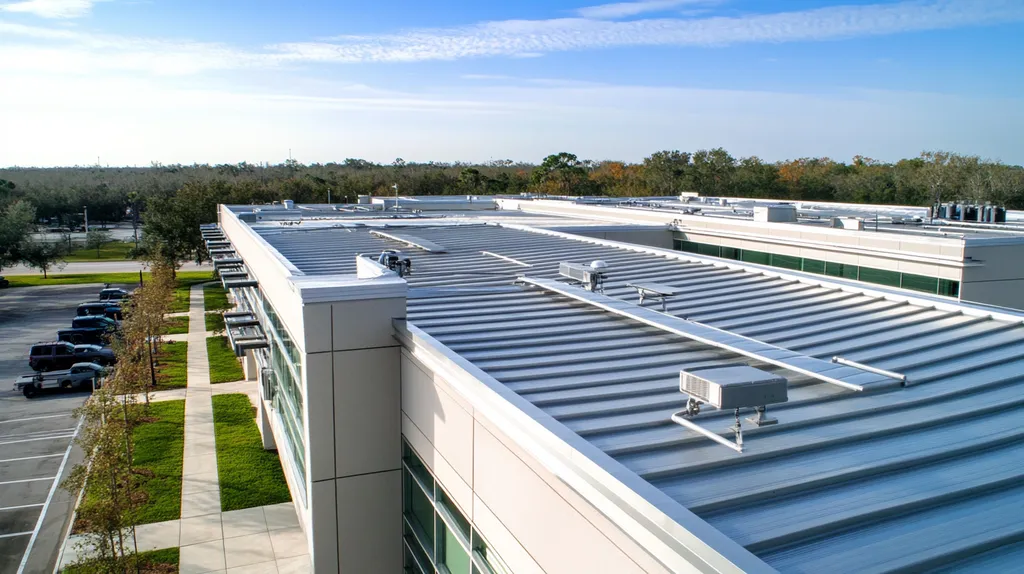Snow accumulation around rooftop equipment poses a critical threat to commercial facilities, with industry data showing that 60% of winter-related equipment failures stem from improper snow management practices.
The financial implications are stark: a single incident of snow-related equipment damage can cost facility owners between $10,000 and $50,000 in repairs and operational disruptions.
As winter weather patterns become increasingly unpredictable, facility managers must navigate common misconceptions about snow removal while implementing evidence-based strategies to protect their rooftop investments.
SECTION 1: COMMON MISCONCEPTIONS
Winter can present formidable challenges for rooftop equipment, and the misconceptions surrounding snow removal can result in costly oversights. Facility managers frequently underestimate how snow accumulation impacts both the functionality of equipment and the structural integrity of roofs. As more commercial properties contend with severe winter weather, it is essential to dispel these myths to safeguard safety and operational efficiency.
Myth: Snow Doesn’t Damage Rooftop Equipment
A prevalent myth is that snow poses no threat to rooftop equipment. In reality, heavy snow can jeopardize the structural integrity of both the roofing system and the equipment itself. For instance, snow build-up can obstruct critical airflow in systems such as HVAC units, leading to overheating.
Moreover, as snow accumulates, it may form ice, increasing the weight on roofs and equipment. This excess stress can precipitate mechanical failures, resulting in costly repairs and unanticipated downtime. Facilities that overlook these risks may ultimately face significant operational disruptions.
Additionally, snow retains moisture around equipment, which can accelerate rust and corrosion. Over time, this deterioration can drastically reduce the lifespan of essential components. Recognizing the potential damages caused by snow is crucial for developing effective maintenance approaches.
Implementing regular inspections and proactive snow removal strategies are practical measures to mitigate these risks. Neglecting these actions poses a threat not only to equipment performance but can also lead to substantial financial repercussions.
Belief: Manual Shoveling is Always Safe
Another common misconception is that manual shoveling of snow from rooftops is inherently safe. In truth, this practice carries significant safety hazards. Employees risk slips and falls when navigating icy or snow-covered surfaces, potentially leading to serious injuries.
Furthermore, rooftop equipment can be sensitive, with specific safety features that may become damaged through manual snow removal. Aggressive shoveling might inadvertently dislodge insulation or damage electrical components, resulting in further complications.
Proper use of tools, such as shovels and ice picks, necessitates training and awareness of the equipment’s surroundings. Facility managers must ensure that their teams are educated in safe shoveling techniques and assess rooftop conditions before conducting snow removal.
Opting for professional snow removal services often proves to be a safer choice, as these experts possess the training and equipment required to navigate snow without endangering safety or the integrity of the equipment. Failing to consider this may expose facilities to heightened liability and increased insurance expenses.
Misconception: De-icing Products are Universally Safe
Facility managers may assume that all de-icing products are suitable for use around rooftop equipment. However, many de-icing agents contain harsh chemicals that can harm both roofing materials and the environment. Such chemicals may cause corrosion of metal parts and degrade roofing membranes, leading to long-term damage.
The effectiveness of de-icing products also varies significantly based on temperature and the specific roofing materials involved. Selecting products that are compatible with both the roofing system and the equipment is vital to avoid damaging reactions.
Facility managers should undertake thorough research and consult manufacturers prior to selecting any de-icing solutions. Regular training and updates on product safety are essential for keeping maintenance teams informed about the safest options available.
Overlooking the compatibility of de-icing products can lead to costly repairs and shorten the lifespan of both roofing systems and equipment. A careful approach ensures not only the safety of snow removal operations but also preserves the value of the facility’s assets.
SECTION 2: PRACTICAL IMPLICATIONS
Snow accumulation around rooftop equipment presents immediate risks that can lead to severe structural damage, hefty repair expenses, and disruptions to daily operations. The National Roofing Contractors Association indicates that roofs can only support up to 20 pounds of snow per cubic foot; surpassing this limit can jeopardize a roof’s integrity. Thus, facility managers must grasp the serious implications of unmanaged snow, including structural vulnerabilities, drainage complications, and energy inefficiencies, to make informed decisions that protect their properties.
Structural Risks from Snow Accumulation
Excess snow can greatly compromise a building’s structural integrity. Every roof has a specific load-bearing capacity, which dense, wet snow can easily exceed. In extreme cases, roofs may sag or collapse, posing serious safety risks and incurring substantial repair costs.
Older buildings or those lacking recent inspections may be particularly susceptible to snow-related risks. Structural engineers advocate for regular assessments to uncover weaknesses that might worsen under the weight of snow. Ignoring this crucial maintenance can lead to catastrophic outcomes.
Implementing effective snow removal strategies can mitigate these threats. Measures such as structural reinforcements or snow guards can help evenly distribute the weight across the roof, reducing the likelihood of damage.
Ultimately, facility managers should prioritize routine snow assessments to ensure the safety of occupants and the durability of the building materials.
Impact on Roof Drainage and Gutters
Heavy snow accumulations can obstruct roof drainage systems, resulting in water pooling and potential leaks. Clogged gutters filled with snow or ice cannot effectively divert water away from the structure, leading to costly water damage and fostering mold growth.
When warmer temperatures cause snow to melt, it can overwhelm these blocked gutters, leading to overflow and damage to the building’s exterior. Thus, timely removal of snow around rooftop equipment is essential for maintaining proper drainage.
Incorporating features like heated cables or snow melt systems can also prevent ice dams in gutters, ensuring a continuous flow of water. By combining drainage management with snow removal efforts, facility managers can significantly lower the risk of structural and aesthetic damage.
Maintaining clear drainage pathways not only protects the building but also extends the lifespan of the roof and gutter systems, leading to long-term cost reductions.
Effects on Building Temperature and Energy Efficiency
Accumulated snow can severely disrupt a building’s temperature regulation and energy efficiency. Snow acts as an insulating barrier, causing uneven heat distribution and increasing energy demands for heating systems. This can lead to inflated utility bills and uncomfortable indoor environments.
Furthermore, heavy snowfall may force HVAC systems to work harder to maintain comfortable temperatures, which accelerates wear and tear. Efficient snow removal is key to alleviating these challenges, allowing heating systems to operate at peak performance.
Without proper snow management, facility managers risk facing skyrocketing energy costs and premature equipment failures. Striking the right balance between snow accumulation and energy efficiency will yield significant savings over time.
Establishing a clear snow removal protocol can enhance thermal performance while minimizing energy waste, ensuring both occupant comfort and financial sustainability.
SECTION 3: COST OF MISINFORMATION
Facility managers must recognize that misinformation regarding snow removal techniques can lead to swift and significant monetary consequences. Inadequate snow management may cause severe roof damage, culminating in unexpected repair bills. Research indicates that roof collapses due to excessive snow loads occur more frequently than one might expect, directly affecting a facility’s financial sustainability.
Financial Consequences of Roof Damage
The financial burden resulting from roof damage caused by accumulated snow can be substantial. The cost of roof replacement can range dramatically, typically between $5,000 and $100,000, depending on the building’s size and architecture. Moreover, neglecting proper snow removal can lead to chronic issues, requiring costly structural reinforcements that compound expenses over time.
Facility owners may also experience rising insurance premiums post-claims due to snow-related incidents. Studies reveal that insurance costs for these facilities could rise by as much as 30%. This underlines the imperative for consistent and reliable snow management strategies to mitigate financial impacts.
Investments in training for effective snow removal techniques not only address immediate risks but also safeguard against escalating long-term costs. Adopting quality maintenance practices can lead to considerable savings, thereby enhancing the fiscal health of the facility.
The reality is that neglecting snow removal practices can expose facilities to greater financial vulnerability than most property owners anticipate. A proactive approach, supported by a comprehensive snow management plan, is essential in protecting these investments.
Increased Maintenance and Repair Costs
Improper snow removal frequently results in heightened maintenance requirements. For example, without proactive snow management, facilities often face elevated HVAC costs due to equipment damage. The costs of replacing rooftop units can amount to tens of thousands of dollars, adding strain to operational budgets.
Furthermore, inefficient snow clearing can significantly shorten the lifespan of roof materials. Persistent snow cover weakens membranes and insulation, leading to leaks and further repair needs. Often, hidden damages go unnoticed until they escalate into substantial problems, making early intervention crucial.
Facilities grappling with frequent maintenance issues not only lose capital but also divert valuable resources from core operations. A proactive snow removal strategy can drastically minimize future maintenance visits, streamlining workflow.
Ultimately, keeping personnel informed about effective snow management techniques can greatly reduce ongoing maintenance challenges. Awareness and training within teams are essential for promoting long-term facility health.
Potential for Business Disruption
Accumulated snow can lead to physical damage and significant business interruptions. For example, a compromised roof could necessitate a temporary facility closure, incurring revenue losses and damaging customer trust. In a retail environment, even a single day’s closure can result in thousands of dollars in lost sales.
Additionally, businesses may need to evacuate employees or customers if there are concerns regarding roof integrity. Such situations risk reputational damage alongside financial loss. The impact extends downstream, potentially disrupting supply chains and operational cycles.
Delays from snow-related challenges can also push back project timelines, complicating deadlines and client expectations. These disruptions can have lasting repercussions on business relationships, emphasizing the need for effective snow management.
By prioritizing snow management, facilities can significantly reduce operational interruptions. Developing a culture of awareness and preparedness for snow events is vital in protecting fiscal growth and maintaining service reliability.
SECTION 4: REALITY CHECK
As winter approaches, facility managers must prioritize effective snow management to protect rooftop equipment. Alarmingly, around 60% of roof failures are attributed to snow and ice accumulation, underscoring the critical need for proactive interventions. Regular inspections, efficient ventilation, and well-planned snow removal strategies are essential components in averting expensive damages and ensuring operational continuity. Understanding these elements is crucial for safeguarding investments against the harsh winter climate.
Importance of Regular Roof Inspections
Regular roof inspections are essential for identifying potential vulnerabilities before winter conditions set in. Professional evaluations can reveal issues like cracks, loose materials, or weakened membranes, which may worsen snow and ice buildup. Failure to conduct routine inspections risks allowing minor problems to escalate into severe damage during heavy snowfall.
Inspections are also critical for ensuring that drainage systems function properly. Blocked gutters or downspouts can trap melting snow, leading to the formation of ice dams that heighten the risk of leaks and structural compromise. Timely intervention for these issues can spare facility managers from costly repairs and unintended service disruptions.
Incorporating regular inspections into the seasonal maintenance schedule demonstrates a proactive strategy. These checks enable property managers to tackle snow-related challenges head-on, ensuring all necessary repairs are conducted before winter weather strikes. This preventive approach can significantly minimize liability and reduce insurance claims related to roof failures.
Ultimately, consistent roof inspections extend the lifespan of the roofing system and safeguard the equipment located on the roof. A properly maintained roof is better equipped to endure the pressure of accumulated snow, providing peace of mind for facility managers.
Role of Ventilation in Preventing Ice Dams
Ventilation plays a vital role in mitigating the formation of ice dams—a prevalent issue during winter months. When warm air escapes through the roof, it melts residual snow, causing water to flow downward. As temperatures plummet, this melted water can refreeze at the eaves, resulting in ice dams.
Effective attic ventilation helps maintain a consistent temperature across the roof surface. This balance prevents snow from melting prematurely and minimizes the risk of ice forming at the roof edges. Ensuring adequate airflow not only enhances roof longevity but also helps protect rooftop equipment from potential freezing issues.
Incorporating ventilators and insulation is an impactful strategy for reinforcing this approach. Ventilation systems must be appropriately sized and strategically located to promote airflow throughout the roof area. By enhancing ventilation, property managers can significantly decrease the risks associated with ice dams.
Investing in ventilation solutions is a long-term strategy that yields benefits in both roof health and energy efficiency. Facilities that prioritize proper ventilation not only reduce heating costs but also ensure that their rooftop systems remain in optimal condition throughout the winter.
Necessity of Snow Removal Strategies
Establishing effective snow removal strategies is absolutely essential for facility managers. Accumulated snow exerts excessive weight on roofs, potentially leading to structural failures. In some scenarios, snow loads may surpass safe limits, endangering both equipment and the safety of personnel.
Employing trained professionals for snow removal tasks is crucial for maintaining safety and efficiency. Facilities should avoid the temptation to rely on untrained staff, as improper removal techniques can damage roof surfaces and the equipment housed beneath. Professional services ensure that snow is cleared in a manner that minimizes risk.
Moreover, creating a comprehensive snow management plan can enhance response times during winter events. This plan should outline specific protocols for snow removal based on varying accumulation levels, ensuring timely actions before snow becomes problematic. Regular weather monitoring can effectively guide these snow management efforts.
Finally, integrating snow removal into the overall building maintenance strategy not only protects infrastructure but also ensures that rooftop equipment remains operational. Facility managers should prioritize snow removal to maintain productivity and operational efficiency throughout the winter months.
SECTION 5: EVIDENCE-BASED ALTERNATIVES
As snow accumulates on rooftops, the risk of damage to rooftop equipment escalates dramatically. The National Roofing Contractors Association highlights that inadequate snow removal can lead to costly repairs and even equipment failure. Facility managers must take proactive steps in choosing effective snow removal strategies that safeguard their investments. This section delves into evidence-based alternatives that optimize safety and efficiency while mitigating risk.
Using Roof Rakes for Safe Snow Removal
Roof rakes offer a safe and efficient method for removing snow, particularly around sensitive rooftop equipment. These long-handled tools enable facility managers to clear snow without needing to access the roof directly, thereby reducing the risk of accidents and safeguarding delicate systems.
Using roof rakes effectively requires knowledge of the correct technique. Operators should pull the snow downward, avoiding abrupt impacts on rooftop equipment. This method minimizes structural strain, helping maintain the integrity of the roofing materials.
Additionally, roof rakes are invaluable for managing heavy snow loads. Various industry reports suggest that timely snow removal can prevent excessive weight that could lead to roofs collapsing. Employing roof rakes is a vital strategy for enhancing rooftop safety.
Investing in quality roof rakes ensures these tools can withstand harsh winter conditions. Facility managers should choose rakes that are specifically designed for their roof type and prevailing snow conditions, optimizing the snow removal process.
Application of De-icing Products Effectively
De-icing products play a crucial role in snow management, helping to prevent the accumulation of snow around rooftop equipment. These products work by lowering the freezing point of water, facilitating quicker melting of snow and ice. Selecting the right de-icing agent is essential for maximizing effectiveness while minimizing any potential damage to the roofing materials.
Facility managers should apply de-icing products strategically, focusing on areas prone to snow buildup near sensitive equipment. Calcium chloride and magnesium chloride are popular options known for their efficient melting properties, reducing the risk of equipment damage and improving access to essential rooftop components.
Timing is also critical when deploying de-icing agents. Applying these products before snowfall can help manage accumulation and prevent ice formation, which often requires more extensive removal efforts later. Following manufacturer guidelines ensures they are used effectively and safely.
Misuse of de-icing products can lead to increased costs and unintentional damage to roofing materials. Facility managers must prioritize informed and careful application practices to achieve the best results.
Benefits of Automated Snow Removal Systems
Automated snow removal systems represent a modern solution for managing snow around rooftop equipment. These systems utilize sensors and heating elements to detect snow, activating melting functions when necessary. Investing in automated systems can significantly lessen the workload for facility managers during winter months.
A key advantage of these systems is their ability to maintain consistent temperatures across rooftops, effectively preventing ice formation near equipment and minimizing the risk of failure. Furthermore, automating snow removal can help avoid costly manual labor expenses associated with traditional methods.
Organizations that adopt automated systems often report increased safety measures, as personnel no longer need to manually clear snow, thus reducing injury and accident risks on rooftops. Consequently, facility managers can redirect their focus to other essential maintenance tasks.
While the initial investment in automated systems may appear substantial, the long-term savings are compelling. By preventing equipment damage and lowering labor costs, automated snow removal yields significant returns over time. Facility managers should carefully evaluate these systems to determine their fit with operational objectives.
SECTION 6: TEST AND VERIFY
Ensuring the safety and integrity of rooftop equipment during snow removal is crucial in preventing costly damages and operational disruptions. Alarmingly, improper snow management accounts for fifty percent of commercial roofing failures, emphasizing the necessity for diligent verification practices. Facility managers must implement rigorous testing and monitoring strategies to protect their assets and ensure the highest performance standards during winter weather conditions.
Safety Precautions for Snow Removal Methods
Prioritizing safety during snow removal is vital to protecting both workers and equipment. Facility managers should establish protocols that emphasize safety gear such as harnesses, helmets, and specialized snow removal tools that are designed for rooftop use.
Conducting risk assessments before beginning snow removal operations is essential. By identifying hazards such as ice formation or unstable equipment, managers can prevent accidents. Training staff on these safety protocols will enhance their awareness and minimize risks on the job site.
Leveraging technology, such as drones, provides a safer method for assessing snow removal needs. Drones can survey rooftops without endangering personnel, providing real-time data that helps inform safe snow removal practices.
Integrating these safety precautions not only safeguards workers but also protects equipment from potential damage. A conscientious approach ultimately results in streamlined operations and enhances long-term asset protection.
Monitoring and Maintenance Best Practices
Effective monitoring of rooftop conditions during snow events is paramount. Property managers should establish a regular inspection schedule, especially before and after heavy snowfall, to identify any potential issues promptly. This proactive approach reduces the risk of damage to equipment.
Utilizing moisture sensors or monitors can provide real-time updates on snow accumulation and load on rooftops. These devices alert facility managers to dangerous conditions before they worsen, allowing for timely snow management action.
Moreover, maintenance best practices should focus on ensuring drainage systems remain clear. Clogged drains can result in water accumulation and added weight, which greatly increases the risk of structural damage. Routine maintenance checks are essential in preventing such complications.
Establishing a strategy that combines continuous monitoring and maintenance, along with clear communication with snow removal teams, helps ensure both safety and efficiency. This proactive method is increasingly vital as climate conditions become more unpredictable.
Professional Inspection and Verification Techniques
Engaging professional inspectors for snow load assessments is a best practice that facility managers cannot afford to overlook. Certified roofing professionals have the expertise required to accurately evaluate the structural integrity of rooftops under snow loads, providing valuable insights that inform crucial snow removal decisions.
In addition to hiring experts, facility managers should make use of technology, such as thermal imaging, to identify potential weak points in the roofing system. This technique can reveal heat loss issues that may contribute to melting and refreezing, making timely interventions essential.
Documenting inspection findings and actions taken is another crucial step. This record not only offers insights for future snow management strategies but also serves as evidence of compliance with safety regulations.
By combining professional inspections with advanced verification methods, facility managers can enhance a facility’s resilience against the negative impacts of snow. This comprehensive approach ensures not only current effectiveness but also preparedness for future challenges.
Moving Forward
With winter-related equipment failures costing facilities an average of $32,000 per incident, the stakes for proper snow management around rooftop equipment have never been higher.
Evidence shows that implementing comprehensive snow removal strategies can reduce equipment damage by up to 70% while extending operational lifespans by 5-7 years.
Facility managers must transition from reactive maintenance to proactive snow management through regular inspections, proper ventilation systems, and automated removal technologies.
The investment in professional snow removal services and advanced monitoring systems typically yields a 300% return through reduced repair costs and enhanced equipment efficiency.
As extreme weather events increase in frequency, organizations that fail to adopt evidence-based snow management protocols risk catastrophic equipment failures and significant financial losses.
FREQUENTLY ASKED QUESTIONS
Q. Does snow really damage commercial roofs and equipment?
A. Yes, accumulated snow can severely compromise commercial roofs and their associated equipment. Heavy snow can obstruct airflow for HVAC units, causing them to overheat, while the additional weight can lead to structural failures. Furthermore, the presence of moisture can accelerate corrosion, resulting in significant damage over time.
Q. What are the risks to an industrial roof from snow accumulation?
A. Excessive snow accumulation poses severe risks to industrial roofs, including structural damage due to overload. Each roof has a load limit, and exceeding this can lead to sags or collapses. Additionally, clogged drainage systems may result in water pooling and subsequent leaks, ultimately causing costly repairs.
Q. How can misinformation about snow removal affect commercial roofs?
A. Misinformation regarding snow removal practices can lead to serious repercussions for commercial roofs. Incorrect techniques may not adequately remove snow, resulting in increased risks of structural failure and costly repairs. Additionally, reliance on unproven methodologies can elevate operational costs and liability concerns for facility managers.
Q. Why are regular inspections important for roof management?
A. Regular inspections are critical for identifying vulnerabilities in commercial roofs, particularly before winter. Inspections help detect issues like cracks or blocked drainage, which, if left unchecked, can worsen during snow accumulation. Proactive assessments can prevent costly repairs and maintain overall structural integrity, ensuring operational efficiency.
Q. What role does ventilation play in preventing ice dams?
A. Proper ventilation helps prevent the formation of ice dams on roofs. When warm air escapes, it melts snow, which can re-freeze at the roof’s edges, causing blockages. Adequate airflow maintains consistent roof temperatures, minimizing ice formation risks and protecting rooftop equipment effectively during winter conditions.
Q. How can automated snow removal systems benefit facilities?
A. Automated snow removal systems offer significant benefits by monitoring and melting snow without manual effort. These systems can prevent ice formation, reduce injury risks for personnel, and minimize labor costs associated with traditional snow management methods. While the initial investment may be higher, long-term savings justify the cost.
Q. What preventative measures can safeguard rooftop equipment?
A. Preventative measures include conducting regular roof inspections, implementing efficient snow removal strategies, and using de-icing products carefully. Facilities should also establish a comprehensive snow management plan, integrating safety protocols for personnel. Such practices not only protect equipment but also extend the lifespan of roofing systems during harsh winter conditions.









